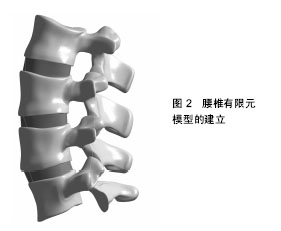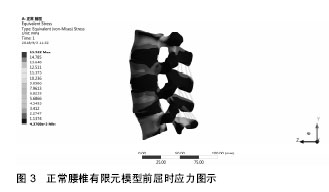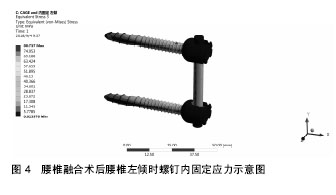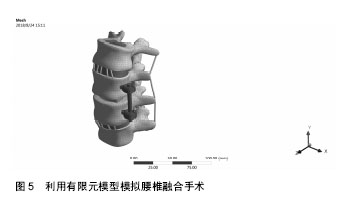| [1] Belytschko T, Kulak RF, Schultz AB, et al. Finite element stress analysis of an intervertebral disc. J Biomech. 1974;7(3): 277-285.[2] 朱磊,霍洪军.有限元分析在强直性脊柱炎后凸畸形中的应用进展[J].中国医药导报,2014,11(7):166-168.[3] 冯其金,赵玲娟,郑昆仑,等.有限元分析法在腰椎生物力学中的研究进展[J].中国中西医结合外科杂志,2018,24(2):255-258.[4] 张振军,李阳,廖振华,等.有限元法在腰椎生物力学应用中的研究进展和展望[J].生物医学工程学杂志,2016,33(6):1196-1202.[5] 苏春涛,眭承志.腰椎三维有限元生物力学分析的技术应用进展[J].中国康复医学杂志,2013,28(5):479-482.[6] 曾至力,程黎明,朱睿,等. 胸腰椎三维非线性有限元模型的建立[J].中华医学杂志, 2011, 91(31): 2176-2180.[7] 赵岩,江建明,李筱贺,等.三维有限元分析脊柱中胸段(T6~8)结核经肋椎单元植入物固定的应力变化[J].中国组织工程研究,2015, 19(17):2762-2767.[8] 王端阳,奚春阳,杨辉,等.有限元分析法在腰椎生物力学研究中的应用及新进展[J].现代生物医学进展, 2015,15(9): 1794-1797.[9] 陈伯华,孙鹏, Natarajan N, 等.颈椎三维有限元模型的建立及意义[J].中国脊柱脊髓杂志,2002,12(2):105-108.[10] 陶勇,吴云乐,宗少晖,等.基于有限元分析腰椎内固定的生物力学特征[J].中国组织工程研究,2016,20(13):1932-1938.[11] Du HG,Liao SH,Jiang Z,et al.Biomechanical analysis of press extension technique on degenerative lumbar with disc herniation and staggeredfacetjoint. Saudi Pharm J. 2016; 24(3):305-311.[12] Rohlmann A, Zander T, Rao M, et al. Applying a follower load delivers realistic results for simulating standing. J Biomech. 2009;42(10):1520-1526.[13] 张慧,张军,钱秀清,等.有限元分析法在脊柱生物力学中的应用与进展[J].中国中医骨伤科杂志,2014,22(10):71-73.[14] 梁得华,鲁世保.有限元分析法在胸腰段脊柱骨折的应用进展[J].北京医学,2016,38(7):706-708.[15] Lotz JC,Colliou OK,Chin JR,et al. Compression-induced degeneration of the intervertebral disc : an in vivo mouse model and finite-element study. Spine. 1998;23(23): 2493-2506.[16] El-Rich M,Arnoux PJ,Wagnac E,et al.Finite element investigation of the loading rate effect on the spinal load-sharing chanes under impact conditions.J Biomech. 2009;42(9):1252-1262.[17] Little JP, Adam CJ, Evans JH, et al. Nonlinear finite element analysis of anular lesions in the L4/5 intervertebral disc. J Biomech. 2007;40(12):2744-2751.[18] Yin N, Xu G, Zhang S, et al. Finite element modeling and analyzing for lumbar muscle electrical activity. COMPEL. 2014; 33(1/2): 106-115.[19] Kim YE, Choi HW. Effect of disc degeneration on the muscle recruitment pattern in upright posture: a computational analysisEffect of disc degeneration on the muscle recruitment pattern in upright posture: a computational analysis. Comput Methods Biomech Biomed Engin. 2014; 15: 1-10.[20] 魏兵,许泽川,常山.有限元法分析腰椎椎弓根螺钉的生物力学特征[J].中国组织工程研究,2018,22(19):3091-3096.[21] 闫家智,吴志宏,汪学松, 等. 腰椎间盘退变后应力变化的有限元分析[J]. 中国医学科学院学报,2009,31(4):464-467.[22] 黄菊英,李海云,吴浩. 腰椎间盘突出症力学特征的仿真计算方法[J].医用生物力学, 2012, 27(1): 96-101[23] Dou H, Tang S. Analysis of the influence of nucleotomy on lumbar degeneration of the operated level using the finite elementmethod.Turk Neurosurg. 2014;24(2): 184-189[24] Salo G, Caceres E, Lacroix D, et al.The effect of end-plate preparation in circumferential arthrodesis of the lumbar spine. a finite element analysis. J Biomech. 2006;SUPP1: 157.[25] Costi J, Stanley R, Smith L, et al. The effect of intervertebral disc degeneration on vertebral cortical strains and disc mechanical properties. J Biomech. 2009;91-B: 435. [26] 王健,朱立新,曹延林.人体腰椎有限元建模及内固定的生物力学研究[J].中华创伤骨科杂志, 2011,13(6):589-591.[27] 张美超,肖进,李义凯,等 .腰椎小关节接触模型的有限元分析[J].第一军医大学学报,2002,22(9):836-838.[28] Cahill PJ, Wang W, Asghar J, et al. The use of a transition rod may prevent proximal junctional kyphosis in the thoracic spine after scoliosis surgery: a finite element analysis. Spine. 2012; 37(12):687-695.[29] Silve MJ, Kearveny TM, Hayes WC. Loading sharing between the shell and centrum in the lumber vertebral body. Spine. 1997;22(2): 140-150.[30] Chen L, Feng Y, Che CQ, et al. Influence of sacral slope on the loading of pedicle screws in postoperative L5/S1 isthmic spondylolisthesis patient: a finite element analysis. Spine. 2016;41(23):E1388.[31] Matsuura Y, Giambini H, Ogawa Y, et al. Specimen-specific nonlinear finite element modeling to predict vertebrae fracture loads after vertebroplasty. Spine. 2014; 39(22):1291-1296.[32] Kumar SN, Meakin JR, Mulholland RC, et al. Analysis of stress distribution in the vertebral bodies using finite element analysis. Orthop Proceedings. 2002;84-B: 140. [33] Sungchul J, Chunkun P, Kwonyong L, et al. Effects of malalignment of total disc replacement on kinematics and load-sharing characteristics of the lumbar spine. Spine. 2010.[34] Rihn JA, Lawrence J, Gates C, et al. Adjacent segment disease after cervical spine fusion. Instr Course Lect. 2009; 58:747-756.[35] 张生,祁学强,常建琪.腰椎不同融合方式对邻近节段影响的三维有限元分析[J]. 延安大学学报(医学科学版),2017,15(4):39-42.[36] Yamasaki K, Hoshino M, Omori K, et al. Risk factors of adjacent segment disease after transforaminal inter-body fusion for degenerative lumbar disease. Spine. 2017;42(2): E86.[37] Chien CY, Kuo YJ, Lin SC, et al. Kinematic and mechanical comparisons of lumbar hybrid fixation using dynesys and cosmic systems. Spine (Phila Pa 1976). 2014;39:E878-E884.[38] Chuang WH, Lin SC, Chen SH, et al. Biomechanical effects of disc degeneration and hybrid fixation on the transition and adjacent lumbar segments: trade-off between junctional problem, motion preservation, and load protection. Spine (Phila Pa 1976). 2012;37:E1488-E1497.[39] 张生,祁学强,常建琪.腰椎不同融合方式对邻近节段影响的三维有限元分析[J].延安大学学报(医学科学版),2017,15(4): 39-42+97.[40] Huang H, Nightingale RW, Dang A. Biomechanics of coupled motion in the cervical spine during simulated whiplash in patients with pre-existing cervical or lumbar spinal fusion:A Finite Element Study. Bone Joint Res. 2018;7(1):28-35.[41] Lee CH, Kim YE, Lee HJ, et al. Biomechanical effects of hybrid stabilization on the risk of proximal adjacent-segment degeneration following lumbar spinal fusion using an interspinous device or a pedicle screw-based dynamic fixator. J Neurosurg Spine. 2017;27(6):643-649.[42] Huang YP, Du CF, Cheng CK, et al. Preserving posterior complex can prevent adjacent segment disease following posterior lumbar interbody fusion surgeries: a finite element analysis. Plos One. 2017;12(2):e0172329.[43] Chun DH , Yoon DH , Kim KN, et al. Biomechanical comparison of four different atlantoaxial posterior fixation constructs in adults. Spine (Phila Pa 1976). 2018;43(15): E891-E897. |
.jpg)





.jpg)
.jpg)